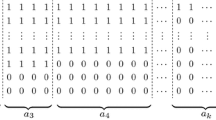Abstract
For a code C=C(n,M) the level k code of C, denoted C k , is the set of all vectors resulting from a linear combination of precisely k distinct codewords of C. We prove that if k is any positive integer divisible by 8, and n=γk, M=βk≥2k then there is a codeword in C k whose weight is either 0 or at most . In particular, if γ<(4β−2)2/48 then there is a codeword in C k whose weight is n/2−Θ(n). The method used to prove this result enables us to prove the following: Let k be an integer divisible by p, and let f(k,p) denote the minimum integer guaranteeing that in any square matrix over Z p , of order f(k,p), there is a square submatrix of order k such that the sum of all the elements in each row and column is 0. We prove that lim inf f(k,2)/k<3.836. For general p we obtain, using a different approach, that f(k,p)≤p(k / ln k )(1+ o k (1)).
Similar content being viewed by others
Author information
Authors and Affiliations
Corresponding author
Rights and permissions
About this article
Cite this article
Alon, N., Litsyn, S. & Yuster, R. A Coding Theory Bound and Zero-Sum Square Matrices. Graphs and Combinatorics 19, 449–457 (2003). https://doi.org/10.1007/s00373-003-0533-0
Received:
Issue Date:
DOI: https://doi.org/10.1007/s00373-003-0533-0



